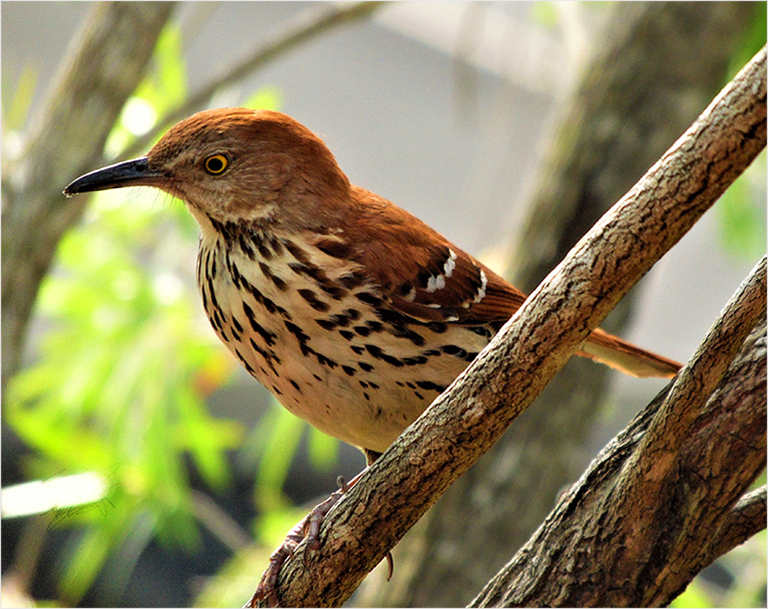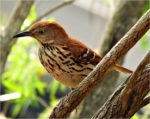
February’s Bird of the Month is the Brown Thrasher, and here is the article in the upcoming February 2019 Kite written by Clive and Celecia Pinnock.
February Bird of the Month – Brown
Brown Thrasher (Toxostoma rufum)
by Clive and Celecia Pinnock
In eastern North America, within habitats composed of dense thickets, shrubs, hedgerows, scrubby fields and overgrown clearings, Brown Thrashers lead inconspicuous lives. These 11.5-in songbirds sport a plumage of reddish brown on their backs and dark streaking on their whitish underparts. Similar in shape but larger in size to their relatives, the Northern Mockingbird and the Gray Catbird, Brown Thrashers have long legs, a long tail and a slightly down-curved beak. The face is gray-brown with yellow eyes, and there are two black and white wing bars on each wing.
Primarily secretive in nature, Brown Thrashers are usually seen lurking in shrubby tangles or foraging on the ground below dense cover. While foraging, they run, walk or hop, using their beaks to sweep through leaf litter, uncovering insects and other invertebrates. Their diet also includes small vertebrates (lizards, snakes and tree frogs), fruit, seeds and nuts. They may sometimes be observed foraging on an open lawn, but, at the slightest disturbance, they dart back to dense cover, where they seem to disappear, due to their cryptic color pattern breaking up their outline.
These birds are most obvious when they are seen and heard singing loudly from tree tops or shrubs. The songs are a combination of many musical phrases and are usually composed of the songs of other songbirds. Within a typical song, a phrase is generally repeated before moving on to other parts of the song. To the keen listener, these repeated (or double) phrases make identifying the singing Brown Thrasher relatively easy.
During the nesting season, their territorial defense of the nest site is noteworthy, since they have been known to attack and strike potential threats (people, cats or dogs) with such force as to draw blood. Mated pairs work together to construct the nest, incubate the eggs, raise and feed the young; however, it is unknown whether the pair remains monogamous year after year or partners are changed annually.
Photographers – please note that next month’s March bird of the month is the Gray Catbird.
Please check out the picture by Nicola Labrador in the February KITE cover and to see the slide show of the entire virtual gallery this month, along with photographer etc — click on BOM SLIDE SHOW below the pictures displayed here:
[flickr_set id=”72157704570227461″ max_num_photos=”100″]
BOM SLIDE SHOW – February 2019 Bird of the Month – Brown Thrasher


Comments are closed